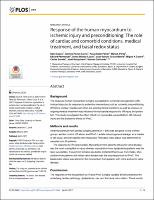| dc.contributor | Vall d'Hebron Barcelona Hospital Campus |
| dc.contributor.author | Casós Vásquez, Kelly |
| dc.contributor.author | Ferrer Curriu, Gemma |
| dc.contributor.author | Soler-Ferrer, Paula |
| dc.contributor.author | Pérez González, MªLlanos |
| dc.contributor.author | Permanyer Buada, Eduard |
| dc.contributor.author | Blasco Lucas, Arnau |
| dc.contributor.author | Gracia Baena, Juan Manuel |
| dc.contributor.author | Castro Alba, Miguel Angel |
| dc.contributor.author | Sureda Barbosa, José Carlos |
| dc.contributor.author | Barquinero Mañez, Jordi |
| dc.contributor.author | Galiñanes Hernández, Manuel |
| dc.date.accessioned | 2021-04-27T11:39:51Z |
| dc.date.available | 2021-04-27T11:39:51Z |
| dc.date.issued | 2017-04-05 |
| dc.identifier.citation | Casós K, Ferrer-Curriu G, Soler-Ferrer P, Pérez ML, Permanyer E, Blasco-Lucas A, et al. Response of the human myocardium to ischemic injury and preconditioning: The role of cardiac and comorbid conditions, medical treatment, and basal redox status. Eckle T, editor. PLoS One. 2017 Apr 5;12(4):e0174588. |
| dc.identifier.issn | 1932-6203 |
| dc.identifier.uri | https://hdl.handle.net/11351/5914 |
| dc.description | Aortic valve; Ischemia; Myocardium |
| dc.description.abstract | Background
The diseased human myocardium is highly susceptible to ischemia/reoxygenation (I/R)-induced injury but its response to protective interventions such as ischemic preconditioning (IPreC) is unclear. Cardiac and other pre-existing clinical conditions as well as previous or ongoing medical treatment may influence the myocardial response to I/R injury and protection. This study investigated the effect of both on myocardial susceptibility to I/R-induced injury and the protective effects of IPreC.
Methods and results
Atrial myocardium from cardiac surgery patients (n = 300) was assigned to one of three groups: aerobic control, I/R alone, and IPreC. Lactate dehydrogenase leakage, as a marker of cell injury, and cell viability were measured. The basal redox status was determined in samples from 90 patients.
The response to I/R varied widely. Myocardium from patients with aortic valve disease was the most susceptible to injury whereas myocardium from dyslipidemia patients was the least susceptible. Tissue from females was better protected than tissue from males. Myocardium from patients with mitral valve disease was the least responsive to IPreC. The basal redox status was altered in the myocardium from patients with mitral and aortic valve disease.
Conclusions
The response of the myocardium to I/R and IPreC is highly variable and influenced by the underlying cardiac pathology, dyslipidemia, sex, and the basal redox status. These results should be taken into account in the design of future clinical studies on the prevention of I/R injury and protection. |
| dc.language.iso | eng |
| dc.publisher | Public Library of Science |
| dc.relation.ispartofseries | PLoS ONE;12(4) |
| dc.rights | Attribution 4.0 International |
| dc.rights.uri | http://creativecommons.org/licenses/by/4.0/ |
| dc.source | Scientia |
| dc.subject | Malalties coronàries - Tractament |
| dc.subject.mesh | Myocardial Ischemia |
| dc.subject.mesh | Ischemic Preconditioning, Myocardial |
| dc.title | Response of the human myocardium to ischemic injury and preconditioning: The role of cardiac and comorbid conditions, medical treatment, and basal redox status |
| dc.type | info:eu-repo/semantics/article |
| dc.identifier.doi | 10.1371/journal.pone.0174588 |
| dc.subject.decs | isquemia miocárdica |
| dc.subject.decs | precondicionamiento isquémico miocárdico |
| dc.relation.publishversion | https://journals.plos.org/plosone/article?id=10.1371/journal.pone.0174588 |
| dc.type.version | info:eu-repo/semantics/publishedVersion |
| dc.audience | Professionals |
| dc.contributor.organismes | Institut Català de la Salut |
| dc.contributor.authoraffiliation | [Casós K, Ferrer-Curriu G, Soler-Ferrer P, Pérez ML] Grup de Teràpia repadora del cor, Vall d'Hebron Institut de Recerca (VHIR), Barcelona, Spain. Vall d'Hebron Hospital Universitari, Barcelona, Spain. Universitat Autònoma de Barcelona, Bellaterra, Spain. [Permanyer E, Blasco-Lucas A, Gracia-Baena JM, Castro MA, Sureda C] Servei de Cirurgia Cardíaca, Vall d'Hebron Hospital Universitari, Barcelona, Spain. Universitat Autònoma de Barcelona, Bellaterra, Spain. [Barquinero J] Grup de Teràpia Gènica i Cel·lular, Vall d’Hebron Institut de Recerca (VHIR), Barcelona, Spain. Universitat Autònoma de Barcelona, Bellaterra, Spain. [Galiñanes M] Grup de Teràpia repadora del cor, Vall d'Hebron Institut de Recerca (VHIR), Barcelona, Spain. Vall d'Hebron Hospital Universitari, Barcelona, Spain. Universitat Autònoma de Barcelona, Bellaterra, Spain. Servei de Cirurgia Cardíaca, Vall d'Hebron Hospital Universitari, Barcelona, Spain. Universitat Autònoma de Barcelona, Bellaterra, Spain |
| dc.identifier.pmid | 28380047 |
| dc.identifier.wos | 000399353500053 |
| dc.relation.projectid | info:eu-repo/grantAgreement/ES/1PN/2008-2011/PI12%2F00119 |
| dc.rights.accessrights | info:eu-repo/semantics/openAccess |

